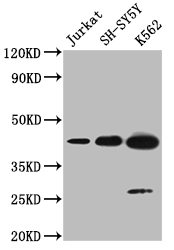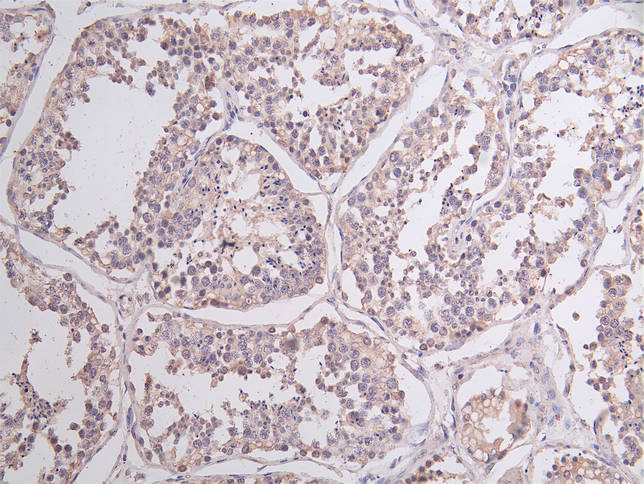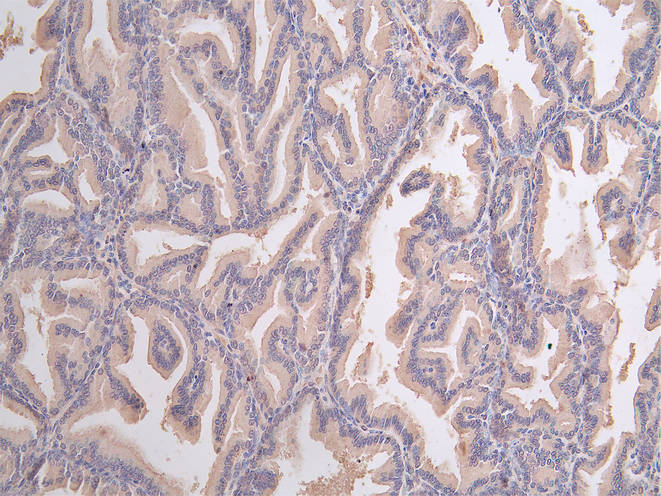NSUN4 Antibody
-
货号:CSB-PA850270LA01HU
-
规格:¥440
-
促销:
-
图片:
-
Western Blot
Positive WB detected in: Jurkat whole cell lysate, SH-SY5Y whole cell lysate, K562 whole cell lysate
All lanes: NSUN4 antibody at 1:2000
Secondary
Goat polyclonal to rabbit IgG at 1/50000 dilution
Predicted band size: 44, 17, 22, 38 kDa
Observed band size: 44 kDa -
Immunofluorescence staining of Human testicular tissue with CSB-PA850270LA01HU at 1:100, counter-stained with DAPI. The cells were fixed in 4% formaldehyde, permeabilized using 0.2% Triton X-100 and blocked in 10% normal Goat Serum. The cells were then incubated with the antibody overnight at 4°C. The secondary antibody was Alexa Fluor 488-congugated AffiniPure Goat Anti-Rabbit IgG(H+L).
-
Immunofluorescence staining of human prostate tissue with CSB-PA850270LA01HU at 1:100, counter-stained with DAPI. The cells were fixed in 4% formaldehyde, permeabilized using 0.2% Triton X-100 and blocked in 10% normal Goat Serum. The cells were then incubated with the antibody overnight at 4°C. The secondary antibody was Alexa Fluor 488-congugated AffiniPure Goat Anti-Rabbit IgG(H+L).
-
Immunofluorescence staining of human colorectal cancer tissue with CSB-PA850270LA01HU at 1:100, counter-stained with DAPI. The cells were fixed in 4% formaldehyde, permeabilized using 0.2% Triton X-100 and blocked in 10% normal Goat Serum. The cells were then incubated with the antibody overnight at 4°C. The secondary antibody was Alexa Fluor 488-congugated AffiniPure Goat Anti-Rabbit IgG(H+L).
-
-
其他:
产品详情
-
产品名称:Rabbit anti-Homo sapiens (Human) NSUN4 Polyclonal antibody
-
Uniprot No.:Q96CB9
-
基因名:NSUN4
-
别名:5 methylcytosine rRNA methyltransferase NSUN4 antibody; EC=2.1.1.- antibody; NOL1/NOP2/Sun domain family member 4 antibody; NOL1/NOP2/Sun domain family, member 4 antibody; NOP2/Sun domain family, member 4 antibody; Nsun4 antibody; NSUN4_HUMAN antibody; Putative methyltransferase NSUN4 antibody; RP4-603I14.2 antibody; Shtap antibody; Sperm head and tail associated protein antibody
-
宿主:Rabbit
-
反应种属:Human
-
免疫原:Recombinant Human 5-methylcytosine rRNA methyltransferase NSUN4 protein (26-284AA)
-
免疫原种属:Homo sapiens (Human)
-
标记方式:Non-conjugated
本页面中的产品,NSUN4 Antibody (CSB-PA850270LA01HU),的标记方式是Non-conjugated。对于NSUN4 Antibody,我们还提供其他标记。见下表:
-
克隆类型:Polyclonal
-
抗体亚型:IgG
-
纯化方式:>95%, Protein G purified
-
浓度:It differs from different batches. Please contact us to confirm it.
-
保存缓冲液:Preservative: 0.03% Proclin 300
Constituents: 50% Glycerol, 0.01M PBS, PH 7.4 -
产品提供形式:Liquid
-
应用范围:ELISA, WB, IHC
-
推荐稀释比:
Application Recommended Dilution WB 1:1000-5000 IHC 1:20-1:200 -
Protocols:
-
储存条件:Upon receipt, store at -20°C or -80°C. Avoid repeated freeze.
-
货期:Basically, we can dispatch the products out in 1-3 working days after receiving your orders. Delivery time maybe differs from different purchasing way or location, please kindly consult your local distributors for specific delivery time.
相关产品
靶点详情
-
功能:Involved in mitochondrial ribosome assembly. 5-methylcytosine rRNA methyltransferase that probably is involved in mitochondrial ribosome small subunit (SSU) maturation by methylation of mitochondrial 12S rRNA; the function is independent of MTERFD2/MTERF4 and assembled mitochondrial ribosome large subunit (LSU). Targeted to LSU by MTERFD2/MTERF4 and probably is involved in a final step in ribosome biogenesis to ensure that SSU and LSU are assembled. In vitro can methylate 16S rRNA of the LSU; the methylation is enhanced by MTERFD/MTERF4.
-
基因功能参考文献:
- It involves in epigenetic changes during the progression of Alzheimer disease pathology. PMID: 24387984
- analysis of the 3D crystal structure of the human MTERF4-NSUN4 complex PMID: 22949673
- Observational study of gene-disease association. (HuGE Navigator) PMID: 19086053
-
亚细胞定位:Mitochondrion.
-
蛋白家族:Class I-like SAM-binding methyltransferase superfamily, RsmB/NOP family
-
数据库链接:
HGNC: 31802
OMIM: 615394
KEGG: hsa:387338
STRING: 9606.ENSP00000419740
UniGene: Hs.163424
Most popular with customers
-
-
YWHAB Recombinant Monoclonal Antibody
Applications: ELISA, WB, IF, FC
Species Reactivity: Human, Mouse, Rat
-
-
-
-
-
-

























